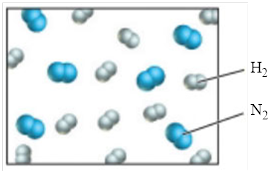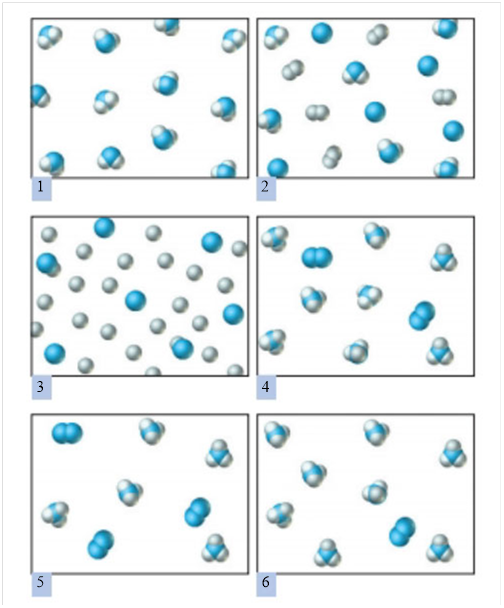
EBK INTRODUCTORY CHEMISTRY: AN ACTIVE L
6th Edition
ISBN: 8220100547508
Author: CRACOLICE
Publisher: Cengage Learning US
expand_more
expand_more
format_list_bulleted
Concept explainers
Textbook Question
Chapter 10, Problem 41E
Ammonia can be formed from a combination reaction of its elements. A small fraction of an unreacted mixture of elements is illustrated in the following diagram, in which white spheres represent hydrogen atoms and blue spheres represent nitrogen atoms. The temperature is such that all species are gases.

a) Write and balance the equation for the reaction.
b) Which of the following correctly represents the product mixture?

c) Which species is the limiting reactant? Explain.
Expert Solution & Answer
Want to see the full answer?
Check out a sample textbook solution
Students have asked these similar questions
solve please
Please answer the question and provide a detailed drawing of the structure. If there will not be a new C – C bond, then the box under the drawing area will be checked.
Will the following reaction make a molecule with a new C – C bond as its major product:
Draw the major organic product or products, if the reaction will work. Be sure you use wedge and dash bonds if necessary, for example to distinguish between major products with different stereochemistry.
Please do not use AI. AI cannot "see" the molecules properly, and it therefore gives the wrong answer while giving incorrect descriptions of the visual images we're looking at. All of these compounds would be produced (I think). In my book, I don't see any rules about yield in this case, like explaining that one product would be present in less yield for this reason or that reason. Please explain why some of these produce less yield than others.
Chapter 10 Solutions
EBK INTRODUCTORY CHEMISTRY: AN ACTIVE L
Ch. 10 - The first step in the Ostwald process for...Ch. 10 - When hydrogen sulfide reacts with oxygen, water...Ch. 10 - Magnesium hydroxide is formed from the reaction of...Ch. 10 - In our bodies, sugar is broken down by reacting...Ch. 10 - Prob. 5ECh. 10 - Aqueous solutions of potassium hydrogen sulfate...Ch. 10 - The first step in the Ostwald process for...Ch. 10 - Butane, C4H10 is a common fuel used for heating...Ch. 10 - The explosion of nitroglycerine is described by...Ch. 10 - According to the reaction 2AgNO3+CuCu(NO3)2+2Ag,...
Ch. 10 - Prob. 11ECh. 10 - Prob. 12ECh. 10 - Prob. 13ECh. 10 - Prob. 14ECh. 10 - The hard water scum that forms a ring around the...Ch. 10 - Prob. 16ECh. 10 - Prob. 17ECh. 10 - Prob. 18ECh. 10 - The Solvay process is multistep industrial method...Ch. 10 - Prob. 20ECh. 10 - Prob. 21ECh. 10 - What mass of NaHCO3 must decompose to produce 448g...Ch. 10 - Prob. 23ECh. 10 - Solid ammonium chloride decomposes to form ammonia...Ch. 10 - What mass of magnesium hydroxide will precipitate...Ch. 10 - Prob. 26ECh. 10 - Prob. 27ECh. 10 - Prob. 28ECh. 10 - The reaction of a dry cell battery may be...Ch. 10 - Prob. 30ECh. 10 - Prob. 31ECh. 10 - Prob. 32ECh. 10 - Calcium cyanamide is a common fertilizer. When...Ch. 10 - Prob. 34ECh. 10 - The Haber process for making ammonia from nitrogen...Ch. 10 - Prob. 36ECh. 10 - Prob. 37ECh. 10 - The simplest example of the hydrogenation of a...Ch. 10 - Prob. 39ECh. 10 - Prob. 40ECh. 10 - Ammonia can be formed from a combination reaction...Ch. 10 - Carbon monoxide reacts with oxygen to form carbon...Ch. 10 - An experiment is conducted in which varying...Ch. 10 - The flasks below illustrated three trials of a...Ch. 10 - A solution containing 1.63g of barium chloride is...Ch. 10 - Prob. 46ECh. 10 - Prob. 47ECh. 10 - Prob. 48ECh. 10 - A mixture of tetraphosphorus trisulfide and...Ch. 10 - Sodium carbonate can neutralize nitric acid by the...Ch. 10 - Prob. 51ECh. 10 - Prob. 52ECh. 10 - Prob. 53ECh. 10 - Prob. 54ECh. 10 - Prob. 55ECh. 10 - Prob. 56ECh. 10 - Prob. 57ECh. 10 - Prob. 58ECh. 10 - Prob. 59ECh. 10 - Prob. 60ECh. 10 - Question 57 through 62: Thermochemical equations...Ch. 10 - Prob. 62ECh. 10 - Quicklime, the common name for calcium oxide, CaO,...Ch. 10 - What mass in grams of hydrogen has to react to...Ch. 10 - The quicklime produced in Question 63 is...Ch. 10 - Prob. 66ECh. 10 - What mass in grams of octane, a component of...Ch. 10 - Calculate the quantity of energy (kJ) transferred...Ch. 10 - Prob. 69ECh. 10 - Classify each of the following statements as true...Ch. 10 - Prob. 71ECh. 10 - What mass in grams of calcium phosphate will...Ch. 10 - Prob. 73ECh. 10 - Prob. 74ECh. 10 - A laboratory test of 12.8g of aluminum ore yields...Ch. 10 - How much energy is required to decompose 1.42g of...Ch. 10 - Prob. 77ECh. 10 - Prob. 78ECh. 10 - A sludge containing silver chloride is a water...Ch. 10 - Prob. 80ECh. 10 - Prob. 81ECh. 10 - Prob. 82ECh. 10 - Prob. 83ECh. 10 - Prob. 84ECh. 10 - In 1866, a young chemistry student conceived the...Ch. 10 - Prob. 86ECh. 10 - A student was given a 1.6240-g sample of a mixture...Ch. 10 - A researcher dissolved 1.382g of impure copper in...Ch. 10 - What mass in grams of magnesium nitrate, Mg(NO3)2,...Ch. 10 - Prob. 90ECh. 10 - Prob. 10.1TCCh. 10 - Solutions of zinc bromide and sodium hydroxide are...Ch. 10 - Prob. 2PECh. 10 - Prob. 3PECh. 10 - How mass of fluorine is formed when 3.0grams of...Ch. 10 - Prob. 5PECh. 10 - Prob. 6PECh. 10 - Prob. 7PECh. 10 - Prob. 8PECh. 10 - Prob. 9PECh. 10 - A solution containing 43.5g of calcium nitrate is...Ch. 10 - Prob. 11PECh. 10 - Prob. 12PECh. 10 - Prob. 13PECh. 10 - Prob. 14PECh. 10 - Prob. 15PECh. 10 - Prob. 1PCECh. 10 - Prob. 2PCECh. 10 - Prob. 3PCECh. 10 - Prob. 4PCECh. 10 - Prob. 5PCECh. 10 - Prob. 6PCECh. 10 - Eight problem-classification examples follow. Test...Ch. 10 - Prob. 8PCE
Knowledge Booster
Learn more about
Need a deep-dive on the concept behind this application? Look no further. Learn more about this topic, chemistry and related others by exploring similar questions and additional content below.Similar questions
- Please answer the question and provide detailed explanations.arrow_forwardAll of these compounds would be produced (I think). In my book, I don't see any rules about yield in this case, like explaining that one product would be present in less yield for this reason or that reason. Please explain why some of these produce less yield than others.arrow_forward5. Fill in the missing molecules in the following reaction pathway. TMSO Heat + CI then HF O₂N (1.0 equiv) AICI 3 OMearrow_forward
- e. O₂N NO2 1. excess H2, Pd/C 2. excess NaNO2, HCI 3. excess CuCNarrow_forwardHelp with a periodic table task.' Procedure Part 1: Customizing a Periodic Table Use a textbook or other valid source to determine which elements are metals, nonmetals, metalloids (called semimetals in some texts), alkali metals, alkaline earth metals, transition metals, halogens, and noble gases. Download and print a copy of the Periodic Table of Elements. Use colored pencils, colorful highlighters, or computer drawing tools to devise a schematic for designating each of the following on the periodic table: Group numbers Period number Labels for these groups: alkali metals, alkaline earth metals, transition metals, inner transition metals (lanthanides and actinides), other metals, metalloids (semimetals), other nonmetals, halogens, and noble gases Metals, nonmetals, and metalloids Note: Write the group and period numbers and color/highlight each element for categorization. Be sure to include a key for the schematic. Take a photo of the completed periodic table and upload the…arrow_forwardDon't used hand raiting and don't used Ai solutionarrow_forward
- Can you explain these two problems for mearrow_forward个 ^ Blackboard x Organic Chemistry II Lecture (m x Aktiv Learning App x → C app.aktiv.com ← Curved arrows are used to illustrate the flow of electrons. Using the provided starting and product structures, draw the curved electron-pushing arrows for the following reaction or mechanistic step(s). Be sure to account for all bond-breaking and bond-making steps. Problem 28 of 35 :OH H HH KO Select to Edit Arrows CH CH₂OK, CH CH2OH 5+ H :0: Donearrow_forwardCan you explain those two problems for me please.arrow_forward
- Do we need to draw the "ethyne" first for this problem? im confusedarrow_forwardCan you explain how this problem was solved.arrow_forwardQuestion 2 show work. don't Compound give Ai generated solution So (J K-1 mol-1) A 26 B 54 C 39 D 49 At 298 K, AG° is 375 kJ for the reaction 1A + 1B → 4C + 2D Calculate AH° for this reaction in kJ.arrow_forward
arrow_back_ios
SEE MORE QUESTIONS
arrow_forward_ios
Recommended textbooks for you
 Introductory Chemistry: An Active Learning Approa...ChemistryISBN:9781305079250Author:Mark S. Cracolice, Ed PetersPublisher:Cengage Learning
Introductory Chemistry: An Active Learning Approa...ChemistryISBN:9781305079250Author:Mark S. Cracolice, Ed PetersPublisher:Cengage Learning World of Chemistry, 3rd editionChemistryISBN:9781133109655Author:Steven S. Zumdahl, Susan L. Zumdahl, Donald J. DeCostePublisher:Brooks / Cole / Cengage Learning
World of Chemistry, 3rd editionChemistryISBN:9781133109655Author:Steven S. Zumdahl, Susan L. Zumdahl, Donald J. DeCostePublisher:Brooks / Cole / Cengage Learning Chemistry for Today: General, Organic, and Bioche...ChemistryISBN:9781305960060Author:Spencer L. Seager, Michael R. Slabaugh, Maren S. HansenPublisher:Cengage Learning
Chemistry for Today: General, Organic, and Bioche...ChemistryISBN:9781305960060Author:Spencer L. Seager, Michael R. Slabaugh, Maren S. HansenPublisher:Cengage Learning- Chemistry: Matter and ChangeChemistryISBN:9780078746376Author:Dinah Zike, Laurel Dingrando, Nicholas Hainen, Cheryl WistromPublisher:Glencoe/McGraw-Hill School Pub Co
 Introductory Chemistry: A FoundationChemistryISBN:9781337399425Author:Steven S. Zumdahl, Donald J. DeCostePublisher:Cengage Learning
Introductory Chemistry: A FoundationChemistryISBN:9781337399425Author:Steven S. Zumdahl, Donald J. DeCostePublisher:Cengage Learning Introductory Chemistry: A FoundationChemistryISBN:9781285199030Author:Steven S. Zumdahl, Donald J. DeCostePublisher:Cengage Learning
Introductory Chemistry: A FoundationChemistryISBN:9781285199030Author:Steven S. Zumdahl, Donald J. DeCostePublisher:Cengage Learning

Introductory Chemistry: An Active Learning Approa...
Chemistry
ISBN:9781305079250
Author:Mark S. Cracolice, Ed Peters
Publisher:Cengage Learning

World of Chemistry, 3rd edition
Chemistry
ISBN:9781133109655
Author:Steven S. Zumdahl, Susan L. Zumdahl, Donald J. DeCoste
Publisher:Brooks / Cole / Cengage Learning

Chemistry for Today: General, Organic, and Bioche...
Chemistry
ISBN:9781305960060
Author:Spencer L. Seager, Michael R. Slabaugh, Maren S. Hansen
Publisher:Cengage Learning

Chemistry: Matter and Change
Chemistry
ISBN:9780078746376
Author:Dinah Zike, Laurel Dingrando, Nicholas Hainen, Cheryl Wistrom
Publisher:Glencoe/McGraw-Hill School Pub Co

Introductory Chemistry: A Foundation
Chemistry
ISBN:9781337399425
Author:Steven S. Zumdahl, Donald J. DeCoste
Publisher:Cengage Learning

Introductory Chemistry: A Foundation
Chemistry
ISBN:9781285199030
Author:Steven S. Zumdahl, Donald J. DeCoste
Publisher:Cengage Learning
Bonding (Ionic, Covalent & Metallic) - GCSE Chemistry; Author: Science Shorts;https://www.youtube.com/watch?v=p9MA6Od-zBA;License: Standard YouTube License, CC-BY
Stoichiometry - Chemistry for Massive Creatures: Crash Course Chemistry #6; Author: Crash Course;https://www.youtube.com/watch?v=UL1jmJaUkaQ;License: Standard YouTube License, CC-BY